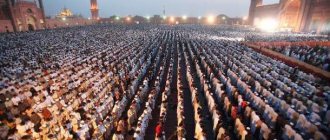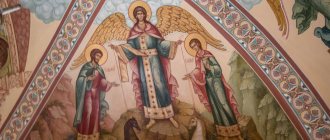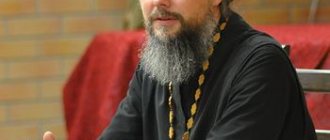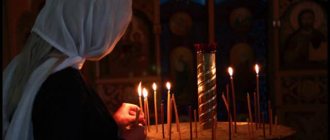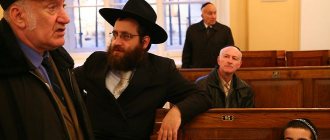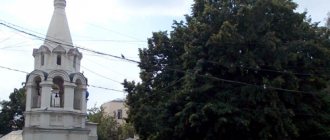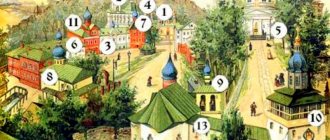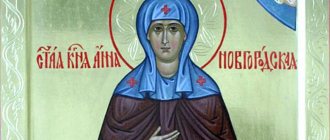| Maalyulinsky Feklinsky Monastery. Photo ok. beginning XXI century |
Convent of Equal-to-the-Apostles Thekla in Maaloula
, stauropegy of the Antiochian Orthodox Church
- Address: Syria, Damascus governorate, Al-Kutaifa district, Maaloula village
- Tel.: +963 (11) 7770003
- On the map: Yandex.Map, Google map
The monastery arose at the entrance to the gorge of a gaping mountain, which, according to legend, saved Equal-to-the-Apostles Thekla from her pursuers.
Some point to Saint Thekla as the creator of the monastery [1]. We can speak with greater confidence about the founding of the monastery in the century, which still makes it one of the oldest in Greater Syria. The monastery was built in two stages: in the first stage, the cave located in the eastern part of the mountain, which rises above the monastery, was expanded, in the southern part of which there is a tomb with the relics of St. Thekla. On the side of the cave there was a church with a stone throne and an altar carved into the rock.
In the 17th century, the Patriarch of Antioch Macarius son of Zaim established the exact location of the tomb of St. Thekla in the monastery.
| Maalula Monastery of St. Thekla. Photo: www.biancoloto.com |
In the 18th century, new construction began at the monastery: the nuns of the monastery, with their own money, built their cells in the northern part of the complex, on the rocks.
In the second half of the century, a new church was erected in the southern part of the monastery in the name of St. John the Baptist [2]. At the beginning of the 21st century, the monastery operated an orphanage and a school for orphan girls, opened by the abbess of the monastery Pelagia (Sayaf). She also founded a workshop in which orphanage pupils and schoolgirls practice embroidery, bead weaving and other crafts. On September 21, 2008, at the monastery, on the initiative of the International Foundation for the Spiritual Heritage of St. Apostle Paul, the opening of a sculptural image of the Lord Jesus Christ by the Russian Alexander Rukavishnikov was scheduled [3].
| Inside the Maalula Monastery after the defeat by jihadists at the end of 2013. Photo of the French “Observatory of Christianophobia” from the portal sedmitza.ru |
During the Syrian civil war, at the beginning of September 2013, the village was briefly captured by terrorist rebels who tried, on pain of death, to persuade the villagers to convert to Islam.
At this time, the monastery gave shelter to about a hundred inhabitants, and also allowed 27 orphans to hide in the caves. The monastery was shelled and invaded by militants, but escaped the massacre [4]. Then, on the morning of November 30, the forces of the so-called. The “Syrian opposition” - in particular, the extremist group Jabhat al-Nusra - again penetrated into the territory of Maalouli, and soon again broke into the monastery they had previously destroyed. On December 2, government fighters repeatedly tried unsuccessfully to break through to the monastery. This time the militants took Abbess Pelagia and eleven nuns hostage; the monastery was subjected to pogrom. In April 2014, Maaloula was finally liberated by government forces, after which the restoration of the village and monastery began. The restoration of the monastery was carried out by Syrian and Russian specialists. As of the beginning of August 2018, the nuns returned, monastic life in the monastery was resumed, restoration work was almost completed: it remained to complete the repairs on the second and fourth floors and install electricity [5].
Statistics
- OK. beginning 2000s - approx. 15 nuns [6]
The Cradle of Christianity: Maaloula and Seydnaya
Good day! In the last post we walked through the streets and bazaars of Damascus, and today we will go to the outskirts of this city - to the villages of Seydnaya and Maaloula . I doubt that you have ever heard these unpronounceable names, except perhaps from the latest news: militants captured Maaloula, Assad’s troops recaptured Maaloula, etc. Nevertheless, these places are of great interest among scientists and are very attractive to tourists, naturally, in calmer times.
Maaloula and Seydnaya are located very close, but, oddly enough, there is no transport connection between them. To visit both settlements, you need to take one bus from the Zablatani bus station in Damascus, go to one of the villages, then return to Damascus, change to another bus and thus get to the second. It is obvious to the naked eye that no one thought about tourists here, although Maaloula and Seydnaya are quite popular attractions in Syria. However, difficulties with transport did not interfere with our plans, and we began our exploration of the outskirts of Damascus from Maalouli.
Holy places of Lebanon
Many events in biblical history are associated with Lebanon. The picturesque grandeur of the Lebanese mountains, on the tops of which lie white snow caps, the “glory of Lebanon” is sung in the Holy Scriptures. “The Well of Living Waters”, the legendary Hermon, many kilometers of underground caves and numerous Christian shrines - all this is Lebanon. Speaking about it, one cannot fail to mention the sacred Lebanese cedars, which are mentioned in the Bible. They were used by King Solomon during the construction of the Jerusalem Temple.
The main places visited by Orthodox pilgrims:
Deir Seyidat al-Nuriyah
Deir Seyidat an-Nuriya is the oldest Orthodox monastery in Lebanon. In the monastery there is a revered image of the Mother of God, which miraculously survived the fire. Church of St. Great Martyr George the Victorious (Amyun), preserving the ancient miraculous Byzantine icon of the Mother of God, which has been streaming myrrh since 1995.
Kaftun Monastery
Kaftun Monastery is one of the oldest Orthodox monasteries in the country. It is known as a center for translation and copying of scriptures and books during the Middle Ages. The monastery contains the only ancient icon of Lebanon from the 13th century, double-sided: on one side - the Mother of God and Child, on the other - the Baptism of the Lord.
Deir el Balamand
Deir el-Balamand is one of the largest Orthodox theological and educational centers in the Middle East. The monastery has icons from the 17th to 19th centuries and medieval manuscripts.
Byblos
Byblos (37 km from Beirut) is one of the most ancient cities in the world. In the city there is a temple of the Mother of God, which was built on the ruins of a pagan temple. In Cana or Kanna-al-Jalil, Christ, according to Scripture, performed his first miracle: he turned water into wine at a wedding. Near the village there are rock reliefs made by the hands of the first Christians, who hid from their pursuers in a cave nearby. Also in Cana is the so-called Mausoleum of Galilee, a sacred building built from the stones of an ancient temple.
In the Sayidat al-Manzar cave near the village of Magdouche, the Virgin Mary waited for Jesus while he preached on the southern coast of Lebanon. Pilgrims from all over the world come to these places to pray, especially on the birthday of the Mother of God.
In Cana or Kanna-al-Jalil, Christ, according to Scripture, performed his first miracle: he turned water into wine at a wedding.
In the Lebanese capital, Beirut, there is the Church of St. Great Martyr George the Victorious. It was restored and opened for the Easter holidays in 2002.
Pilgrims also visit Sarepta, where the prophet Elijah lived and performed miracles, the village of Bakhmadun, where the relics of Elijah Karam, a prayer book for the Russian land, are buried, as well as the ancient Cathedral of St. John the Baptist.
Concepts and definitions
- A monastery is a place of deeds of monks who observe a single charter. A monastery is also commonly understood as the community of monastics itself. The main officials of the monastery include the abbot, treasurer, confessor, dean, sacristan, and housekeeper.
- Monasticism (monk from Greek - solitary, living alone) is a way of life for Orthodox ascetics who devote themselves to prayer. Monks in Russia are called monks, and monasticism is called monasticism.
- An anchorite is a hermit, hermit. This is the customary name for a Christian ascetic who has withdrawn from the world and lives in complete solitude, who has completely devoted himself to repentance, prayer and the knowledge of God.
- Kinovit is an Orthodox monk, an inhabitant of a monastery of communal rules or kinovia. Unlike an anchorite, he receives everything he needs from the monastery, works and prays together with other monks.
- A stylite is a holy ascetic who labored on a pillar: a tower or a high, inaccessible platform of rock.
We would like to thank the Radonezh pilgrimage service for their assistance in preparing the material.
Prayers
In their prayer appeals to Saint Thekla, believers ask for healing, improved health, and family relationships.
About strengthening faith
O heavenly flower of chastity, o the first martyr of the New Testament, O Theklo, the bride of Christ, equal to the angels, purified by suffering and infused with the apostolic preaching, shone with purity, prosperous with many deeds and fragrant with glorious miracles! To whom let us liken you, O God-called one, who has trampled on every soul-destroying deception, pouring out the Holy Spirit into a vessel, a reservoir of wisdom, a source of healing, which cools the flames of all passions! Like a bright cloud, come and wash us with the rain of your prayer from mental and physical defilements. I have kindled a fire of love on my skin, make our hearts chaste and ignite love for Christ. As a sign of unyielding courage in suffering, strengthen our wavering hearts with the saving power of the Cross of the Lord; as our strong champion, I will take out those who are at enmity against us, the weak, and give us an invincible fiery shield, so that the cold demons, scorched by your prayers, may flee from us, and our bodies will be like temples of the Holy Spirit. To her, Theklo, wise and virtuous, turn away our eyes from the lusts of this world, so that we may betroth ourselves to Christ with an immaculate conscience; May our lamps be filled with the oil of chastity; we have sinned greatly by not maintaining fidelity to the Bridegroom Christ, and for this reason the imams have shut themselves outside the Bridal Chamber. Otherwise, do not reject your children who are praying to you, but, like a compassionate helper, clothe us in the vestments of the faith of strength, gird our loins with purity for the mortification of passions and the renewal of the spirit; Moreover, adorn our souls with meekness and humility, so that as children of God, like the lambs and sheep of Christ, we may pass through the temptations of this wicked world without restraint, and may we reach the longed-for Palace of Paradise, where all the wise virgins stand before the Throne of the Bridegroom of Christ, chanting the venerable Name of the Father and the Son , and the Holy Spirit, now and forever. Amen.
About healing from burns and illnesses
O blessed holy first martyr, virgin equal to the apostles, the most praiseworthy Theklo, the true bride of Christ, the beauty of the firmament of the church, the mental morning star of Heaven, the most luminous bead of purity and chastity, the fragrant blossom of the garden of Eden! You, who loved the very life of the only Lord more than all the good things, who suffered well for His Name, who was wondrously crowned by Him with the crowns of virginity, martyrdom and apostleship, who were included in the face of Heaven, even though you now rejoice in eternal glory, but did not abandon us who honor you, as a vigilant intercessor and merciful intercessor before God. And since your Bridegroom, sweetest Jesus, has given you the great grace, we humbly pray to you: heed the request of our hearts, do not leave us orphans in this world; visit us in the prison of existing sin, quickly raise us to vigorous repentance, teach our souls and bodies to maintain purity, direct us to the path of good deeds, inhale zeal towards the Gospel, infuse prayers with holy fire and lead us to Divine love. She, the kindly victorious first sufferer, since you can ask for many benefits from the Most Merciful Jesus our Savior, be a quick helper in this life. Intercede for us with angelic protection, heal the wounds and ulcers of the sick, send down grace-filled joy to those who mourn, protect youth and adolescence with purity, assist monks in labor and obedience, maintain indissoluble marriage, create invincible warriors in battles, and waste enemies of the faith and the Holy Church.
Pour out, O chosen one of Christ, your prayer for us to the Lord, that He may grant us a blameless course of life, a painless, comfortable, and peaceful old age; I am not ashamed of my death, the Mysteries of the Most Holy, the Body and Blood of His Divine One, I am a participant in the Kingdom of Heaven, and may we abide there with the ranks of Angels, and sing together with the saints in the Trinity of the glorified God, the Father, and the Son, and the Holy Spirit, to endless ages centuries. Amen.
About healing from illnesses of soul and body
O holy servant of God, equal to the Apostles to the First Martyr Theklo! Having fought a good fight on earth, you have received in Heaven the crown of righteousness, which the Lord has prepared for all who love Him. In the same way, looking at your holy image, we rejoice at the glorious end of your life and honor your holy memory. You, standing before the Throne of God, accept our prayers and bring them to the All-Merciful God, to forgive us every sin and help us against the wiles of the devil, so that, having been delivered from sorrows, illnesses, troubles and misfortunes and all evil, we will live piously and righteously in the present We will be worthy through your intercession, even though we are unworthy, to see good on the earth of the living, glorifying the One, in His saints glorifying God, the Father and the Son and the Holy Spirit, now and ever and unto the ages of ages. Amen.
Seydnaya (Sayednaya, Saydnaya)
Just 27 km from Damascus there is another ancient settlement with Christian sights - Seydnaya , known to historical sources as Danaba, at least from the 6th century. BC. Wikipedia claims that it was here that the ancient Aramaic language spoken by Christ was preserved. I won’t argue, but in the tourist brochures that I brought from Syria, Maaloula is still given this honorary title.
Almost immediately, Seydnaya became an important Christian place of pilgrimage , as a result of which many churches and monasteries were built in a small space. Chronicles say that in 1618 there were 365 religious buildings here, some of which have safely survived to this day. I found this information in a brochure given to me in the Church of Hagia Sophia, the foundation of which dates back to the 6th century.
The name "Seydnaya" comes from the Aramaic word "saydanaya", which means "hunt" or "hunting place". It's hard to imagine, but once upon a time there were dense forests suitable for hunting.
The main “must see” of Saydnaya is the monastery of Our Lady (“Convent of our Lady of Saydnaya”), built in the 6th century by Emperor Justinian I himself, at least that’s what some authoritative historians think. And the main treasure of the monastery is the icon painted by St. Luke, which pilgrims from all over the world come to venerate. The Virgin Mary, under the name Mariam, is also revered in Islam as the mother of the prophet Isa, so this place is a shrine not only for Christians, but also for Muslims.
The monastery is located on a hill, and a rather long staircase leads to it, climbing which for some pilgrims is already a feat.
But from its observation platforms there is an excellent view of a typically Arab city and desert surroundings.
I really liked the monastery itself: it has many cozy, clean courtyards, chapels and bright halls, most of which are open to the public. Only the cells of nuns and novices, as well as outbuildings and administrative buildings are closed.
The rules for visiting the Christian shrines of Maalouli and Seydnai were quite loyal and logical . It’s nice that admission everywhere was free, and those who wanted to help the monastery could buy standard church utensils in the appropriate shops. Taking photographs in churches is prohibited, although we didn’t lose much, because... The first Christian churches looked like their status: very modest and ascetic.
OK it's all over Now. Another attraction of Syria, which will be discussed in the next post, simply struck my imagination - I could not understand why we know so little about it. A separate post will be devoted to the fight against this injustice - stay tuned for new blog releases!
